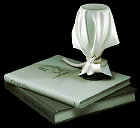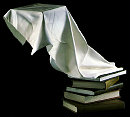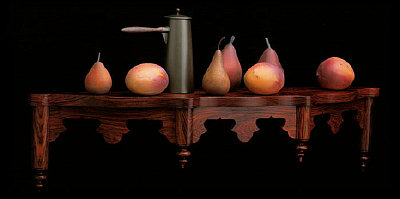|
Written by Tara Blanc - ASU Research Magazine, Spring/Summer 1996
Walk into sculptor Tom Eckert's studio and look around.
It's a large, brightly lit room with plenty of available work surfaces. Benches, counters, and shelves line the walls, while pieces of wood lie neatly stacked in one corner. A bandsaw, a tablesaw, lathes, die grinders, sanders, and hand tools of every size and shape wait patiently for their next project.
A woodworker's paradise to be sure, but a sculptor's studio? There's not a sculpture or objet d'art in sight.
Out of curiosity, you stroll across the room, where the far wall is filled with a series of small, narrow shelves that hold a variety of everyday items. There's one with a ceramic swan-shaped planter sitting on a draped linen napkin. Another holds a jar of ink, some pens, and some brushes. Yet another has a few pieces of fruit, and still another holds a model airplane and a book.
As your gaze jumps from one shelf to another, a niggling little suspicion begins to form. The delicately colored pear looks so appetizing, but is it what it appears to be? And what about those dark green leaves curling out of the ceramic swan? In fact, is the swan, with its glassy, high-gloss finish, really ceramic? But you're sure that if you touch the napkin draped underneath it, you'd feel the smooth softness of linen. Or would you?
You won't. It's not linen, or fruit, or glass. Everything is carved out of wood.
Eckert is a professor at Arizona State University's School of Art. Wood is the medium he uses to express his view of the world through an array of amazingly life-like sculptures.
"The French have a phrase for it -trompe l'oeil, or 'fool the eye,'" Eckert explains. "I like the contrasts in the real and the unreal. The drapery implies a high degree of reality because it's painted and it has a silky appearance. The wood takes on the form of reality, yet it's not real because it's still wooden," he says. "At first you're drawn into a false sense of reality, and then you discover it's not real at all. To me, that's what life is all about."
Eckert's artistic career began in drawing and painting. He says that what he does with sculpture is what a lot of other artists have done with paint.
"A lot of my concepts are 'painterly' ones that I'm translating in a three-dimensional way," Eckert says. "I never really outlived my interest in painting, and now it's all kind of coming together. The illusions that I can get by combining the paint with the three-dimensional aspect of carved wood are really very strong."
The arsenal of tools and techniques that Eckert employs to create those illusions include more than those of the traditional woodworker. He uses some high-tech tools as well. Many of the graphics portions of the finished pieces are created by a computer.
For example, a tone-on-tone pattern in the linen napkin was taken from actual fabric and scanned into a computer. Eckert took a hard copy of the scan and had it made into a "transfer," or decal, which he then attached to the carved wood napkin. The graphic image contained in the transfer was then imbedded into the finish Eckert used on the piece.
"I use the computer mostly to create the graphics," Eckert says. "Ultimately, what I want to do is to create the entire image on the computer. But the process is getting more and more complicated. You could spend your whole life just turning on a lathe, or just painting, or just working on the computer. I'm trying to integrate all these things into my images. I just wonder if at some point it will all be over my head."
For now, however, Eckert's integration of techniques results in works of art that are in demand in galleries, at shows, and through commissions. The inspiration for his images comes in one of two ways.
"In general, an artist can create an image by letting the material itself suggest the end product. Or, the artist simply comes up with an idea and then renders it," Eckert explains. "My process vacillates back and forth between the two approaches, but mainly, it's just the idea."
Many of the images Eckert creates are very personal, such as the piece with the "ceramic" swan.
"Every object in my studio has a personal meaning out of my life. It's like an assemblage of images out of my previous existence. My mother had a plant like that on the table and I'd pick at the leaves, things like that."
For other pieces, objects that Eckert creates as commissions, the image comes from the person or organization that commissions the particular piece. Eckert has created images for giant companies such as Apple Computer and McDonald's, as well as for private individuals. All of the pieces portray what Eckert sees and learns about his client.
"It's a portrait. I use various images or objects as metaphor in an attempt to reveal something about the client," Eckert says. "I did a commission for a man who is a cigar smoker and a gambler. There are cards and dice and it's all wooden. There's a .44 magnum revolver with one bullet in the chamber and a chewed cigar. I arrived at the form through an interview with him, talking about what he likes and doesn't like, and watching him chew on his cigar."
Eckert says the intent in all his work is a reflection on the human condition in this culture.
"I think the role of the artist is to reflect his or her existence, to translate or to convey or to carry a message about culture, to mirror or reflect the human condition at that particular time," Eckert says.
"My main reason for doing these objects is a matter of self expression-I do them for myself. Then I realize it's an extension of self, that I'm not going to live forever, and that when my moment comes to leave I want to know that I have these things out there. That means a lot to me."--
Tara Blanc
|
|




|
|



